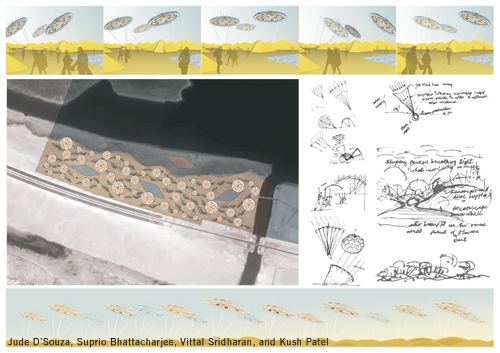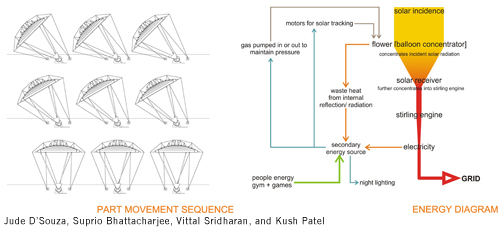Jude D’Souza, Suprio Bhattacharjee, Vittal Sridharan, and Kush Patel
Designed for Site #2 in Abu Dhabi, between Saadiyat Island and Yas Island.
ETT Architects, Mumbai

Design Submission for the 2010 Land Art Generator Initiative Design Competition
Artist’s descriptive text:
On a barren expanse of unrelenting, stark landscape, the desert comes to life.
Sprouting from a sea of dunes, the Desert Blooms bring life, movement and colour in a joyous celebration of nature and her myriad possibilities. The giant Flowers gently follow the path of the sun, and settle down over the dunes for the night. The dunes shelter people and their activities, many of which help tend the Farm of Flowers and keep it thriving.
The Desert Blooms are a playground for a child, a garden for the city, and a source of useful energy for atleast 15000 homes across the country. As the Flowers follow the sun across the sky, they reaffirm Man’s place as part of the interconnected web of Nature, and gesture towards his duty and responsibility to live in harmony with Her.

The site selected for Desert Blooms is the one off the road between Yas Island and Saadiyat Island – chosen both for it simplicity and raw, abstract beauty.
The primary component of the Desert Blooms is a single Flower, that is a gas filled balloon that works as a solar concentrator device. Solar Concentrators in general, are heavy, ground mounted, mirror based systems that require to be situated on vast tracts of open, uninhabited lands (see Appendix 1). The Flower is based on a design of a solar concentrator that is light weight and non – disruptive, does not occupy much ground space, is low cost and modular. Built of gas filled polymer cells mounted onto a lightweight metallic frame, the lower surface of the cells is provided with an assymetric prismatic pattern to focus all incident radiation onto a solar receiver below (see Appendix 2 in conjunction with Sheet 3 for Working).
The balloon is tethered down and braced against wind pressure by cables and a central trio of pylons that also help maintain a fixed aspect between the balloon and the solar receiver at the base at all times. The same cables are controlled in length at the base to provide for solar tracking across the day, and across seasons. The balloons therefore move across the sky through the day, and a motorist driving by in the evening would see a totally different alignment of balloons from what s/he would have seen in the morning.
While the balloons do not need any particular form of base so long as it is rigid, the Desert Blooms develop on the idea of a base to its advantage. The Land Art Generator Project is seen as one that stimulates and draws people’s engagement as involved participants in the work, and not as passive spectators. The Dunescape at the base of the Flowers recalls the creations of the wind in the deserts deeper inland, and many are earth sheltered enclosures, containing within them places for people to inhabit temporarily in their experience of the Desert Blooms. The main energy required to run the complex is for the solar tracking by the balloons. Much of this energy is contributed by people exercising and playing within the dunes on machines that tap their energy to power the movement mechanisms of the Desert Blooms.
The Art / Energy project is thus brought around full circle, with its beneficiaries also acting as its caretakers!
In the evenings, as the sun sets, the Flowers drop down over the dunes, and through a low energy lighting system, breathe light through the night, keeping the place alive for various cultural and social events to take place within and among the dunes. Thus, the Desert Blooms art / generator project attempts to be more than an object for mere viewing, rather becoming a place for people to engage more fully with the installation.
The Dunescape is an inhabited terrain, protected from the harsher aspects of the desert climate by its earth covering. Within the dunes are primarily three functions – the control functions and administrative facilities for the Desert Blooms site, ‘human energy’ zones, and the ‘seed farms’.
Human Energy zones are gymnasiums and play facilities that visitors and regulars can take part in, their expended energy being captured to meet the ancillary energy needs of the Desert Blooms facility itself (see Appendix 3 for Energy Generation Calculations).
Seed Farms are workshops for manufacture of prototypes for the Flowers that may be purchased by visitors or ordered from across the globe. The Desert Blooms, through encouraging active public participation aims to spread its seeds across the world, with humans as its agents of pollination! With a little love and some luck, the Desert Blooms would soon find themselves tiptoeing into various exciting locations across the world …

Appendix 1
Concentrated Solar Power (that involves focusing of large areas of sunlight onto smaller areas for heating or power generation purposes) has been selected due to the relative low costs, and abundance of solar power over other renewable energy sources.
Two primary forms of Concentrated Solar Thermal systems currently in use are linear parabolic troughs and parabolic dishes, both involving reflective mirrors. These systems have certain disadvantages, that are overcome in the design of solar concentrator used for Desert Blooms. Being rigid, ground mounted systems, current technologies have a limitation on their practical size as an increase in size increases the cost of mirrors, and in addition, also the cost of the framing system that holds the mirrors in place. Secondly, because of increased weight due to larger sizes, the solar tracking mechanism also becomes impractical beyond a certain size. Being ground mounted, they cannot be effectively used for medium scale installations such as multistorey residential buildings and office complexes.
The primary differentiation between the system used for Desert Blooms and currently existing systems of Concentrated Solar Power is that unlike current systems, it concentrates solar radiation from ABOVE onto a Solar Receiver located BELOW, occupying minimum amount of ground area, and without the use of heavy and rigid supporting structure. Also, a large quantity of solar radiation is concentrated per unit as the size of an individual Concentrator is maximised.
Appendix 2
A single Flower of the Desert Blooms is made up of Inflatable Concentrator Cells (2) that have an upper surface made of transparent cast polymer (13), and a rigid and prismatic lower surface (14) and are filled with light gas such as hydrogen or helium. The Cells are mounted onto a lightweight metallic frame (3) to form a domical umbrella that allows all incident radiation that is parallel to its axis to be concentrated onto a set area at a fixed distance below, at which the Solar Receiver Assembly (5) is located. The Flower has an additional Inflated Ring (23) on its outer periphery for additional buoyancy. The solar position depending on the time of the day and the time of the year is fed to motors controlling the flywheels at the Cable Rolls and Control Motor Assembly (12) to either draw in a particular cable loop (25, 26 or 27), or release the same to rotate the Flower about the bottom pivot. A Heat Exchanger Coil (16) absorbs excess heat from the Cells which is then put to various ancillary uses.

Appendix 3
Total of 51 balloons within Desert Blooms site.
Total area of Balloons = 124500 sq.m.
Solar Incidence per square metre = 1KW
Collection Efficiency of Balloons = 90%
Conversion Efficiency of heat to electric energy= 50% (using Stirling Engines)
Hence, available electric energy per square metre of balloon = 0.45 KW
Total energy generated during approximately 8 hours of a day = 0.45KW X 124500 sq.m. = 56 MW
Over an 8 hour cycle, this works out to about 450 MWh
At an average consumption of 30KWh per household Desert Blooms generates energy sufficient to power 15000 households in the region.
Related Posts
2 Comments
Add comment Cancel reply
This site uses Akismet to reduce spam. Learn how your comment data is processed.

[…] LandArtGeneratorInitiative Login to post […]
[…] would soon find themselves tiptoeing into various exciting locations across the world. Source: Land Art Generator Initiative Reageer […]